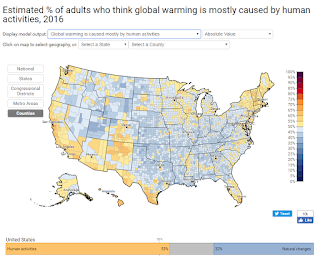Have “forced extrinsic motivators” led to corporations
developing a sense of intrinsic motivation and commitment to pro-environmental
behavior? I ask this question as we face a new era driven by the pursuit of
economic advancement at any and all cost to the environment. This juxtaposes a recent history of an
economy based on promoting and encouraging pro-environmental behaviors for a sustainable,
environmentally responsible economic future for the U.S.
Since 1970, the EPA has regulated corporations and has set
industry standards in order to protect the environment. These regulations, in essence, are extrinsic
motivations. Not rewards, but
consequences. If a corporation
or industry fails to comply, they are “punished” through fines. For example, coal mining waste regulations or
the Clean Water Act.
It seems as though
these regulatory extrinsic motivations have developed a sense of corporate
intrinsic motivation and commitment to environmentally responsible behavior. For example, over a thousand corporations
have independently signed a commitment to align with the Paris Agreement to “combat
climate change”. I’m not entirely sure
what actions companies like Apple, Kellogg, Levi Strauss, and many others will
engage in to fulfill this commitment but at least there’s public accountability
(low-carbonusa.com).
I find it
interesting over a thousand companies signed a declaration, since November
2016, for a low-carbon future:
Not only does
this exemplify the power of pledging and commitment, it is a great example of
re-framing objectives and tailoring the message for its intended target
audience. The target audience: “President Trump, Members of the
US Congress, and Global Leaders” (low-carbonusa.com). Re-framing the message from an
environmental to an economic angle is language the current
economically-obsessed administration can relate to.
The decades since the inception of the EPA fostered a time
for research to be conducted and evidence compiled about anthropogenic effects
on the environment and public health.
This declarative knowledge paved the way for a deeper understanding of
procedural knowledge for corporations to make a choice about engaging in
pro-environmental behaviors or not.
 As regulations face extirpation, the durability of corporate
commitment will certainly be tested. If a company has a true intrinsic
motivation to be environmentally proactive, it will continue to engage in pro-environmental
behavior. At the same time, consumers
(like us in SNRE) can continue the influence of extrinsic motivators (consequences) on companies
and industries choosing otherwise. As
the current administration deregulates environmental policies, we may not have an agency like the EPA to
report “illegal environmental activities”.
As regulations face extirpation, the durability of corporate
commitment will certainly be tested. If a company has a true intrinsic
motivation to be environmentally proactive, it will continue to engage in pro-environmental
behavior. At the same time, consumers
(like us in SNRE) can continue the influence of extrinsic motivators (consequences) on companies
and industries choosing otherwise. As
the current administration deregulates environmental policies, we may not have an agency like the EPA to
report “illegal environmental activities”.
But we, the consumer, can “hit them in the pocket” by not supporting
(purchasing from) companies engaging in environmentally irresponsible
behaviors. Commitment to the environment
develops new social norms when we begin to embrace only those intrinsically
motivated, environmentally responsible companies.
“The only real, practical, hope-giving way to remedy the fragmentation that is the disease of the modern spirit is a small and humble way -- a way that a government or agency or organization or institution will never think of, though a person may think of it: one must begin in one's own life the private solutions that can only in turn become public solutions.”
~Wendell Berry~
Berry, Wendell. 1977. "The Unsettling of America: Culture & Agriculture." San Francisco: Sierra Club.
Gross, Daniel. 03 March 2017. "A Cruel False Promise On Coal". Slate Magazine. Retrieved from http://www.slate.com/articles/business/the_juice/2017/03/trump_s_executive_order_won_t_bring_back_coal_jobs_regulations_aren_t_what.html
lowcarbonusa.org. 2017. "Business Backs Low-Carbon USA." Retrieved from http://lowcarbonusa.org.







